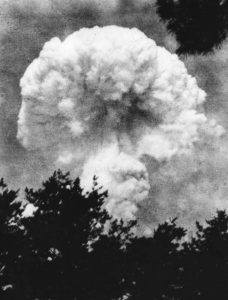Documenting Hiroshima of 1945: Mushroom cloud photographed reflexively
Aug. 6, 2024
by Kyoko Niiyama, Staff Writer
On the morning of August 6, 1945, Seiso Yamada, now 96 but 17 at that time, left his home in the town of Fuchu-cho, Hiroshima Prefecture, holding his camera in hand “without giving it a thought.”
While attending night classes at a junior high school under the former, prewar education system, Mr. Yamada was working part-time at the Chugoku Shimbun. On August 6, he took the day off and headed to Mikumari Gorge, located in his town, to have a cookout with a friend. In the central area of Hiroshima City, where many military facilities were located, “soldiers would yell at people walking around with a camera.” In the mountains, however, there was no such fear.
As they approached the entrance to the gorge, Mr. Yamada remembers seeing rainbow-like ripples in the sky. “Just as I said to my friend, ‘This is weird,’ there was a flash of light and a roaring boom. It was just like ‘pika-don’ (an expression in Japanese used to describe the flash (‘pika’) and blast (‘don’) from the bombing).”
Mr. Yamada quickly threw himself to the ground but then stood up and took a photograph. He said, “It seemed to me like the sun rising from underneath the pine trees. The color of the cloud was like a mixture of red and black paint.” He had no idea about what had just happened.
The location from which he took the photo was about 6.5 kilometers northeast of what was later identified as the hypocenter. Believed to have been taken around two minutes after the detonation, Mr. Yamada’s photo was the earliest taken of the mushroom cloud from ground level.
While they lingered in the mountains, his friend’s mother ran to them and said, “It’s so terrible.” As they went back down the gorge, crowds of people with horribly burned and peeling skin flooded into the area. He realized for the first time that “something extraordinarily horrific had happened.”
(Originally published on August 6, 2024)
On the morning of August 6, 1945, Seiso Yamada, now 96 but 17 at that time, left his home in the town of Fuchu-cho, Hiroshima Prefecture, holding his camera in hand “without giving it a thought.”
While attending night classes at a junior high school under the former, prewar education system, Mr. Yamada was working part-time at the Chugoku Shimbun. On August 6, he took the day off and headed to Mikumari Gorge, located in his town, to have a cookout with a friend. In the central area of Hiroshima City, where many military facilities were located, “soldiers would yell at people walking around with a camera.” In the mountains, however, there was no such fear.
As they approached the entrance to the gorge, Mr. Yamada remembers seeing rainbow-like ripples in the sky. “Just as I said to my friend, ‘This is weird,’ there was a flash of light and a roaring boom. It was just like ‘pika-don’ (an expression in Japanese used to describe the flash (‘pika’) and blast (‘don’) from the bombing).”
Mr. Yamada quickly threw himself to the ground but then stood up and took a photograph. He said, “It seemed to me like the sun rising from underneath the pine trees. The color of the cloud was like a mixture of red and black paint.” He had no idea about what had just happened.
The location from which he took the photo was about 6.5 kilometers northeast of what was later identified as the hypocenter. Believed to have been taken around two minutes after the detonation, Mr. Yamada’s photo was the earliest taken of the mushroom cloud from ground level.
While they lingered in the mountains, his friend’s mother ran to them and said, “It’s so terrible.” As they went back down the gorge, crowds of people with horribly burned and peeling skin flooded into the area. He realized for the first time that “something extraordinarily horrific had happened.”
(Originally published on August 6, 2024)








